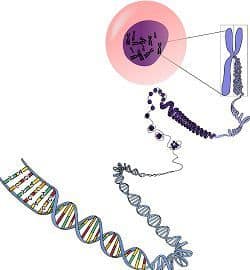
ヘテロクロマチンとユークロマチンは、染色体の一部がしっかりと詰まっていて遺伝的に不活性であり、一方ユークロマチンは染色体が巻き取らず(ゆるやかに)詰まった形で遺伝的に活発なことが大きな違いとしてあげられるでしょう。
分裂していない細胞の核を光学顕微鏡で観察すると、染色の濃度や強さで2つの領域があることがわかります。
ヒトゲノムの約90%は真性染色体である。
ヒトゲノムの約90%が真性染色体であり、クロマチンの一部であり、核内に存在するゲノムのDNAを保護する役割を担っている。 Emil Heitz in the year 1928, coined the term Heterochromatin and Euchromatin.
By focussing on the few more points, we will be able to understand the difference between both types of chromatin. Given below is the comparison chart along with the brief description of them.
Content: Heterochromatin Vs Euchromatin
- Comparison Chart
- Definition
- Key Differences
- Conclusion
Comparison Chart
| Basis for comparison | Heterochromatin | Euchromatin |
|---|---|---|
| Meaning | The tightly packed form of DNA in the chromosome is called as heterochromatin. | The loosely packed form of DNA in the chromosome is called as euchromatin. |
| DNA density | High DNA density. | Low DNA density. |
| Kind of stain | Stained dark. | Lightly stained. |
| Where they are present | These are found at the periphery of the nucleus in eukaryotic cells only. | These are found in the inner body of the nucleus of prokaryotic as well as in eukaryotic cells. |
| Transcriptional activity | They show little or no transcriptional activity. | They actively participate in the process of transcription. |
| Other features | They are compactly coiled. | They are loosely coiled. |
| They are late replicative. | They are early replicative. | |
| Regions of heterochromatin are sticky. | Regions of euchromatin are non-sticky. | |
| Genetically inactive. | Genetically active. | |
| Phenotype remains unchanged of an organism. | Variation may be seen, due to the affect in DNA during the genetic process. | |
| It permits the gene expression regulation and also maintains the structural integrity of the cell. | It results in genetic variations and permits the genetic transcription. |
Definition of Heterochromatin
The area of the chromosomes which are intensely stained with DNA-specific strains and are relatively condensed is known as heterochromatin. They are the tightly packed form of DNA in the nucleus.
The organization of heterochromatin is so highly compact in the way that these are inaccessible to the protein which is engaged in gene expression. Even the chromosomal crossing over is not possible due to the above reason.

ヘテロクロマチンには2つのタイプがあります。
ヘテロクロマチンには、ファカルティヘテロクロマチンと構成的ヘテロクロマチンの2種類があります。 ヒストン・メチル化やRNAiによるsiRNAによってサイレンシングされた遺伝子は、フェイサルヘテロクロマチンと呼ばれます。
一方、テロメアやセントロメアのような反復的で構造的に機能する遺伝子は、構成的ヘテロクロマチンと呼ばれます。
テロメアやセントロメアのような反復的で構造的に機能する遺伝子は、構成的ヘテロクロマチンと呼ばれ、細胞核の継続的性質で、ゲノムに遺伝子は含まれていません。
ヘテロクロマチンの主な機能は、エンドヌクレアーゼによる損傷からDNAを保護することであり、これはそのコンパクトな性質によるものです。
ユークロマチンの定義
染色体のうち、遺伝子の濃度が高く、クロマチンが緩く詰まっている部分をユークロマチンと呼びます。
ユークロマチンは動的ゲノムの最大部分を核の内側まで覆っており、ヒトゲノム全体の約90%を占めると言われている。
転写を可能にするために、活性遺伝子を含むゲノムの一部は緩くパッキングされている。
活性のある遺伝子を含むゲノムの一部は、転写を可能にするために、緩く包装されている。DNAの包装が緩いので、DNAが容易に利用できる。
ユークロマチンは、DNAからRNAへの転写に積極的に関与している。
ユークロマチンは、DNAからRNAへの転写に積極的に関与し、遺伝子制御機構は、ユークロマチンをヘテロクロマチンに変化させるプロセス、またはその逆のプロセスである。
ユークロマチンに存在する活性な遺伝子は、転写されてmRNAを作り、さらに機能タンパク質をコードすることがユークロマチンの主な機能である。
ヘテロクロマチンとユークロマチンの違い
ヘテロクロマチンとユークロマチンを区別するポイントは次のとおりです。
ヘテロクロマチンはサテライトDNAを含み、セントロメアを取り囲み、ファカルティヘテロクロマチンは分解されています。
真核細胞やその内部構造は比較的複雑だと言えるでしょう。